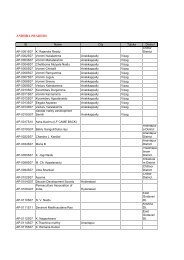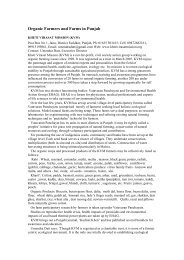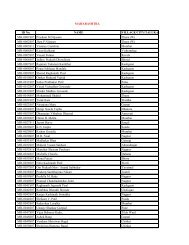Western Ghats Kokum Foundation - Organic Farming Association of ...
Western Ghats Kokum Foundation - Organic Farming Association of ...
Western Ghats Kokum Foundation - Organic Farming Association of ...
You also want an ePaper? Increase the reach of your titles
YUMPU automatically turns print PDFs into web optimized ePapers that Google loves.
WOW! ‘Wine Of Waste’ tropical fruits<br />
Miguel Arcanjo Braganca and Dr. John Carmo Rodrigues, Goa<br />
It is possible to make fruit wine from tropical fruits, with or without addition <strong>of</strong><br />
external sugar source. The process is <strong>of</strong>ten fruit specific and can be organic if rigorous<br />
attention is paid to hygiene during crop production and post harvest processing <strong>of</strong> the fruit<br />
and sugar source. Different fruits have different biologically active compounds and, hence,<br />
there is a need to explore the possibilities <strong>of</strong> using fruits hitherto not used commercially for<br />
wine-making. Inspired by the tremendous work done for the development <strong>of</strong> OrWine from<br />
grapes, a concerted effort was made in Goa, India, to produce a good quality wine <strong>of</strong> tropical<br />
fruit with consumer acceptability. This paper discusses the work done on one such fruit.<br />
Ever since the inhibiting effect <strong>of</strong> hydroxyl citric acid (or HCA) on lipogenesis was<br />
reported by Dr. John Lowenstein, there has been a growing interest in the Garcinia species<br />
to control obesity. Antioxidants and poly-phenols, biologically active compounds found in<br />
red wine, are reported to have beneficial effects. In the Vedic era <strong>of</strong> ancient India, wine was<br />
known as soma or sura and drunk in religious rituals. Medical research has shown that<br />
consuming a small glass <strong>of</strong> red wine daily can help cure diabetes Type 2. The opportunity<br />
to use fruits that are grown organically by tradition and to make wine on a commercial scale<br />
through an organic process needs to be considered with the seriousness it deserves.<br />
<strong>Kokum</strong> is a fruit species native to the <strong>Western</strong> coast <strong>of</strong> India known as the Konkan, <strong>of</strong><br />
which the state <strong>of</strong> Goa is the centre with the cities <strong>of</strong> Mumbai (Bombay) and Kochi (Cochin)<br />
near the two extremes. Locally known as <strong>Kokum</strong>, Bhirand or Birinda and in Portuguese as<br />
Brindao or Brindonna, it is a close relative <strong>of</strong> the Mangosteen, Garcinia mangostana Linn.<br />
The maroon-red rind has been used in the Konkan cuisine as a souring agent for meat and<br />
fish curries and to break down the mucilage in some vegetables like Abelmoschus esculenta.<br />
It is also consumed as a post-lunch drink, with coriander, green chili, garlic and as<strong>of</strong>oetida<br />
as optional additives. The ripening <strong>of</strong> fruits <strong>of</strong>ten coincides with the onset <strong>of</strong> the South-<br />
West monsoon rains, thereby preventing their sun drying as per the traditional practice.<br />
<strong>Kokum</strong> rind is used to make syrup, and in recent times, into a juice or RTS drink with<br />
TSS adjusted 20 Brix and acidity to 0.3% with the addition <strong>of</strong> sugar and citric acid as<br />
needed. This has opened up an opportunity to process the late season fruits. This waste <strong>of</strong><br />
edible fruits can now be prevented by use for aseptic packaging and processing into valueadded<br />
products including fermentation into wine.<br />
The recipes for wine making were closely-guarded household secrets in Goa. A large<br />
area <strong>of</strong> Goa was a colony <strong>of</strong> Portugal for 451 years (25 November, 1510 to 19 December,<br />
1961), while others were under Portuguese influence for shorter periods. Each family clan<br />
had its own brand <strong>of</strong> wine with a body, flavour and bouquet that was different from the rest.<br />
The recipes were rarely written and generally passed from generation to generation by<br />
hands-on learning. Mr. Edwin Saldanha put all the secret recipes he knew and tips on wine<br />
making in a manuscript and published it as a book. The slim 95 (now 105) pages book was<br />
as iconoclastic as the atom bomb over Hiroshima in 1945 and as path-breaking as the<br />
discovery <strong>of</strong> the Bordeaux mixture in 1885. More people are now able to understand and<br />
experiment with wine-making. The development <strong>of</strong> the Garcinia wine since 2005 is one <strong>of</strong><br />
the down-line benefits <strong>of</strong> this book.<br />
90<br />
Resource Book on <strong>Kokum</strong> (Garcinia indica Choisy)<br />
<strong>Western</strong> <strong>Ghats</strong> <strong>Kokum</strong> <strong>Foundation</strong>, Panaji - Goa





